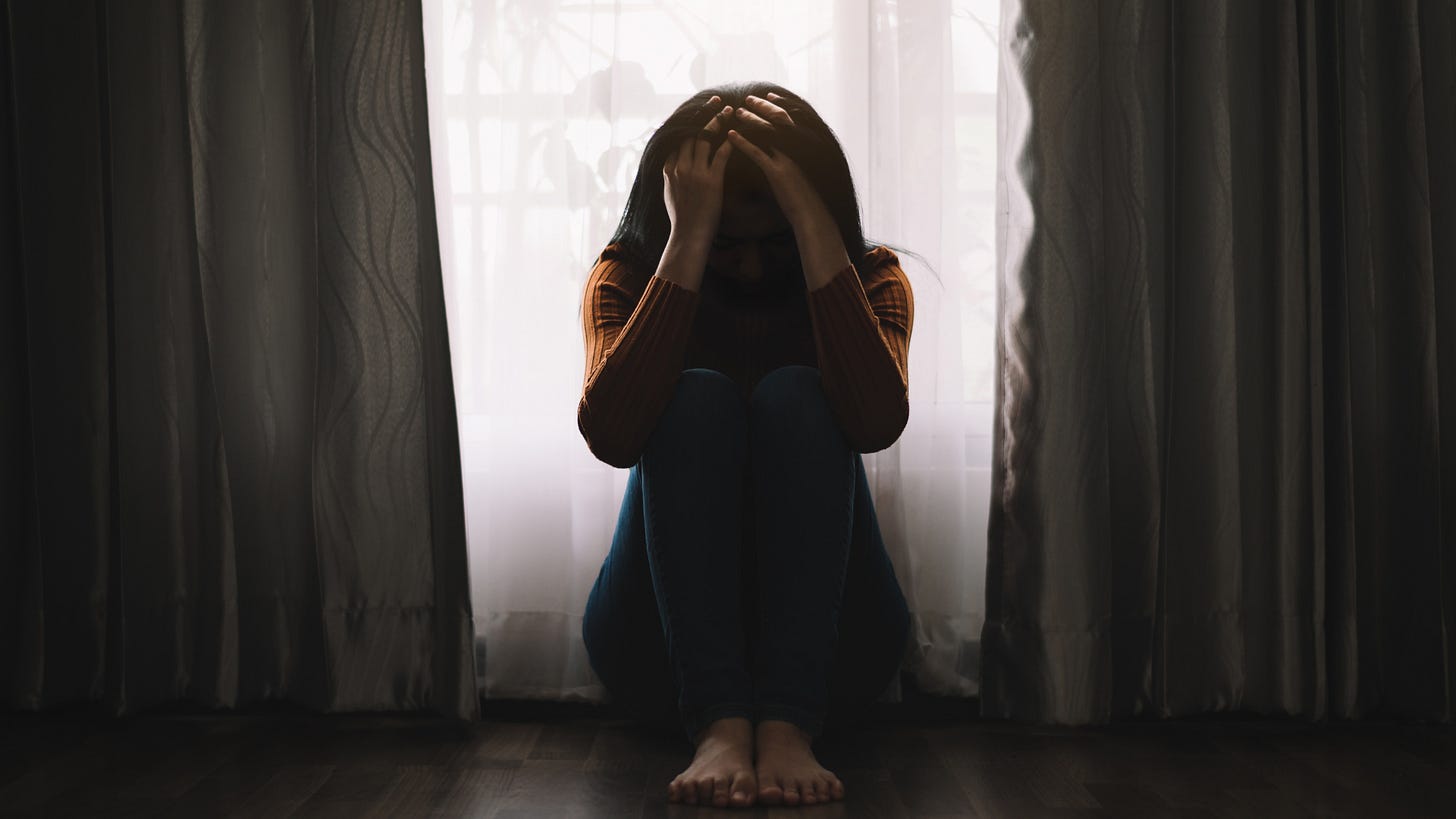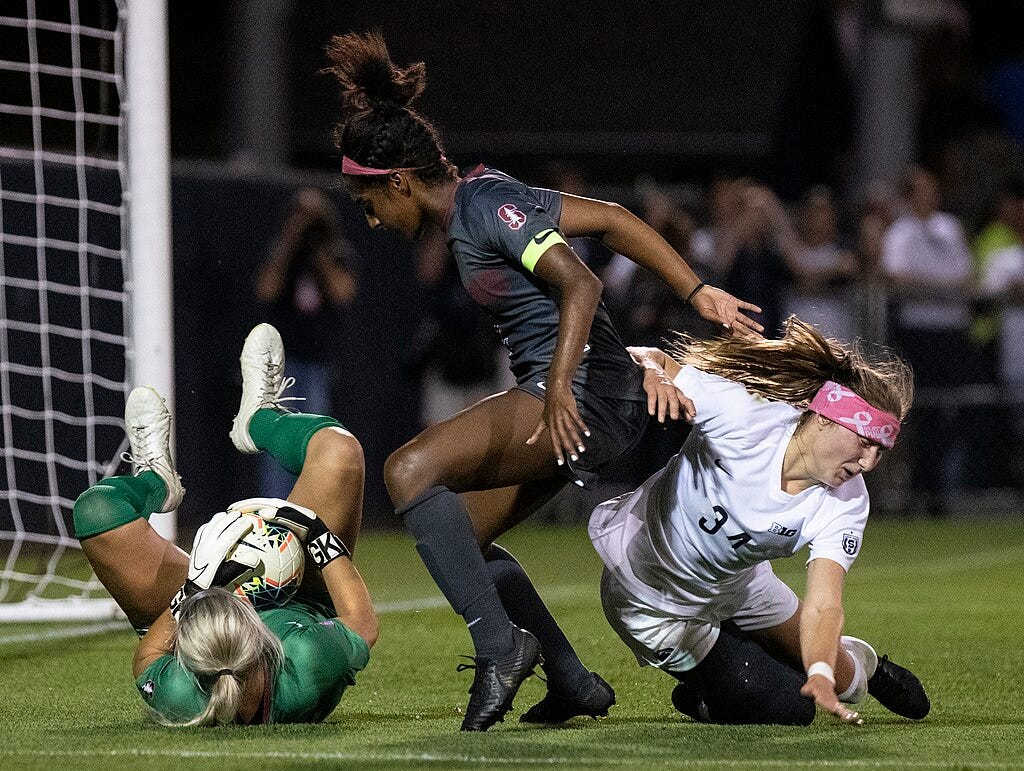The Mental Health Crisis Facing Female College Athletes
This story was first published on our original website on Dec. 2nd, 2023
Katie Meyer appeared to be on top of the world.
The star goalkeeper for Stanford helped secure the NCAA title for the Cardinals in 2019 by saving two key goals in overtime. Meyer’s teammates would later describe her to a journalist as having a “larger-than-life personality” that echoed in the locker room and on campus. Despite her assembly line-like workload, the 22-year-old student-athlete studying international relations made it to the dean’s list her senior year—all while advocating on her social media for gender equality and mental health.
She always strived to be perfect, according to her parents. But just a few hours after a FaceTime call, on March 4, Meyer was found dead in her dorm room.
The promising soccer star had killed herself.
Despite their elevated platforms and material benefits, student athletes are human like everyone else and able to experience psychological distress. But a mental health crisis among them in the United States is getting little attention in the broader conversation about mental health in higher education.
In fact, suicide is the third-leading cause of death for college athletes with the biggest risk factors being depression, anxiety, and substance abuse problems, research at the State University of New York, Brockport found. Thirty percent of student athletes reported feeling overwhelmed and 25 percent admitted to being mentally exhausted, according to a study by the American College of Sports Medicine. Yet only 10 percent said they felt like they received adequate care.
The statistics are even worse for women, who the same study found face higher levels of anxiety and depression than their male counterparts. Women student athletes are also disproportionately prone to mental health problems such as eating disorders and societal pressures like beauty standards—all of which are added to the gender-based problems women face in the real world.
“All it takes is one bad day for something to go wrong,” said Matthew Yellis, a mental health counselor at Boston College. “Female [athletes] have to tackle, school, society, and their sport every day. It’s hard.”
Including BC.
Elizabeth Foster slowly walked into her chaotic dorm room scattered with unwashed clothes, Hershey wrappers, and notebook paper.
The 20-year-old rower with silky brown hair sighed as she placed her red BC Reebok backpack on her wooden desk. Something was bothering her. But it wasn’t the condition of her room that was clogging her mind. It was the perfectly placed posters of her favorite female celebrities hanging on the wall, including Olivia Rodrigo, Simone Biles, and Helen Glover. Although she wanted to “be more like” her role models, she couldn’t stop staring at one thing about all of them – their bodies.
“I see all these models or athletes every day and get disappointed that I can’t be like that,” Foster said. “It is very difficult.”
Like many women student athletes, Foster said she suffers from “tremendous” anxiety about her body. Nearly one in five female college athletes has an eating disorder, according to the Nationa Institute of Health. This anxiety, according to Foster, a sophomore at BC, stems from trying to meet societal standards of beauty and the necessary weight requirements for rowing.
“Rowing requires you to bulk up,” said Foster, who has been rowing for three years. “But just to look pretty I feel like I must be skinny. My mind gets so lost on what to do.”
Foster said she was so confused about the inconsistent perception of weight that she would alternately eat too little or eat too much—making herself sick.
“Although I am much better now, I remember having eating problems my freshman year,” Foster said, putting her head down after taking off her Harry Potter-like glasses. “I would feel so mentally out of it from not eating. My body was craving food, but I didn’t want to give it any.”
Despite the anxiety about her body, at 5-foot-3 and 143 pounds, Foster is only a few pounds outside a ‘normal' body-mass index — typical for an athlete, since muscle is denser than fat — but she insists on describing herself as ‘bulky’ and ‘chubby.’
To make matters worse, Foster said social media, especially Instagram, exacerbates the need to look perfect and worsens the disappointment of not meeting these standards—continuing a toxic cycle to which the social media app has subjected young women. That is why she deleted most of her social media apps and had to “detach from that life.”
“I don’t look at Instagram anymore, even though I love the app,” Foster said, holding her iPhone 11 she keeps in a pink phone case sparkling with glitter. “It is kind of sad but that’s the reality of my mental state sometimes.”
Foster’s experience with body image issues isn’t unique at BC, according to Yellis.
“I see a lot of body trauma,” Yellis said. “Social media is a reason…. Sometimes eating is financially difficult. There is just a constant consciousness of weight here from athletes.”
Although Foster, a Boston native, continues to struggle with body image issues, her rowing team has provided her with a community of support, instead of “pressuring her to be something she is not,” she said.
“I am doing so much better because of my team,” Foster said, smiling at the pictures of teammates on her wall. “We all go through similar problems; my team is like a sisterhood in which we rely on each other to do better.”
——
Since joining the BC women’s hockey team in 2019, Julia DiFiore has missed only four out of 60 brutal hockey games in her past three seasons. The BC junior’s teammates describe her as a hardworking leader who always brings out the best in them.
But DiFiore, 21, from Easthampton, doesn’t feel she is getting the recognition and attention she and her team deserve.
“Women’s athletics doesn’t get much attention at all,” DiFiore said as her freckle-filled face nodded in disappointment. “It sucks that we all work so hard but it there is no feeling of appreciation.”
DiFiore has been noticing general neglect of female sports since she began playing hockey in her freshman year at Williston Northampton School. Whether it was the absence of fans at BC’s Alumni Stadium or the lack of reshares on BC’s women’s hockey Instagram, the 5-foot-4 forward has always been upset by society neglecting her and other women athletes.
—
So much that it affects her confidence.
“My biggest mental challenge has been my self-esteem, but it worsens because there is just no love or appreciation for the work that my team and I put in,” said DiFiore, who also has pictures of her teammates on her dorm room wall.
“Obviously there are amazing benefits with my team and the support of those who care about us, but I think we deserve better.”
Although students in general are prone to self-esteem issues, female athletes report facing higher rates of it than males, according to the AMCS survey.
And—just as for Foster– it’s only worsened by the toxicity on social media apps. DiFiore’s issues with social media aren’t the photos but the comments.
Social media abuse targets female athletes three times more often than male athletes, according to a survey conducted by Plan International, a gender equality advocacy group. Nearly a quarter of the negative comments were sexist and a fifth derided women’s abilities as athletes.
“The toxic environment comes in the comment section,” DiFiore said as she adjusted her caramel-colored hair. “If you see a highlight of a female athlete, people find a way to belittle her.”
Despite “the haters,” however, DiFiore said she is getting better with her confidence issues – especially because of her teammates.
“My teammates always remind me of my value,” DiFiore said while wearing her BC women's hockey team hoodie. “They are my best friends, and their bond is more important than any hurtful word.”
—
Nancy Shannan lives to be in the water. Once a week, the 21-year-old sailor goes to the Chestnut Hill Reservoir to enjoy the water’s cool breeze like a cup of morning coffee. It is her form of mental escape – or a type of meditation – in a world that doesn’t seem to prioritize her mind despite her “overwhelming” workload
“I have a lot on my mind, just like most college athletes do, but I have always haven’t been able to get the adequate care,” Shannan said while wearing a BC cap to protect her brown straight hair from frizzing.
Like other college athletes, Shannan faces pressures from school, anxiety about her future career, and struggles to find the right romantic partner. But to Shannan, a Connecticut native and a junior at BC — like other female college athletes —the pressure keeps her from seeking help because her sport often “demands too much.”
A third of student athletes struggled to find energy for other tasks because of the physical and psychological demands of their sports, a 2015 NCAA study found. A quarter felt mentally exhausted by their day-to-day activities.
“I love sailing, but it affects my sleep, school, my body, and social life at times,” Shannan said while itching her brown eyes with bags underneath them. “I can’t find the time to do any self care or activities to improve my mental state if I really wanted to.”
Despite sailing since she was 14 years old, the 5-foot-6 sailor has been plagued by injuries – another setback that not only prevents her from seeking assistance but also worsens her mental health. College athletes with injuries suffer from mental health issues including depression from isolation, anger, and sleep disturbance, a study by the NCAA showed.
“I recently tore my labrum,” Shannan said, pointing to her left shoulder. “How could I focus on my mental health when my physical health needs attention constantly?”
Members of BC’s athletic mental health team, such as Yellis, said the school does everything it can to help students such as Shannan with their physical and mental health by providing a plethora of resources.
“We know that student athletes go through a lot,” Yellis said. “And that is why we provide everything we can including specific mental health counselors for our athletes. But if students don’t come to us, we can’t help them.”
Shannan, like many college athletes, doesn’t agree that her university provides adequate mental health care. Fewer than half of student athletes who sought help for mental health issues reported satisfactory care from their universities, a 2015 NCAA study found.
Shannan’s issues with BC are more specifically about its culture.
“I don’t think BC creates a culture that pushes mental health,” Shannan said. “Sure, us athletes have lots of resources, but BC doesn’t create a general environment that helps us prioritize our mental health. We all have to juggle so much in our lives and BC doesn’t want to help with that.”
Regardless of whether BC creates a “culture of mental health,” Shannan says she keeps pushing through the work because of her passion for being in the water
“My sport is tough, but I love it,” Shannon said, gazing at pictures of herself sailing. “It is my form of mental escape that nobody can take away from me. It keeps me going.”
—
From Foster’s body-image issues to DiFiore’s self-esteem problems, women athletes face an overwhelming number of problems that disproportionately affect their mental health.
Yet none of their stories are as daunting as what ultimately happened to Stanford’s Katie Meyer—even if some believe it could have been them.
“She was just like me,” Foster said. “I still can’t believe this happened. She must have gone through so much, just like how all the athletes go through.”
Despite having such different experiences with BC Athletics, Foster, DiFoire, and Shannan all believe more work needs to be done on the college athletic scene, especially for women. They want to see more women encouraged to participate in sports, without being shamed about their bodies, and with the mental health help, they need.
The athletes also want people to remember Meyer’s story as a reminder that mental health isn’t something to push to the side.
“We need to do better,” DiFiore said. “I hope Katie’s story can help bring a long-awaited change needed for college athletics.”
Rahim Jessani




